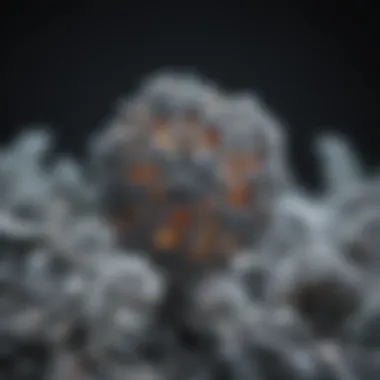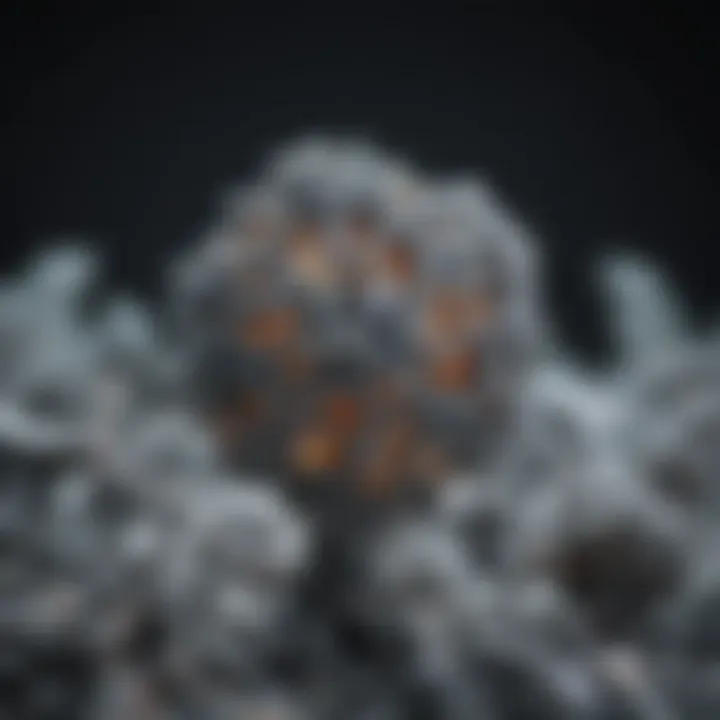Exploring Raney Nickel: Composition and Applications


Intro
Raney nickel is a pivotal catalyst in numerous chemical reactions, crucial for industries that seek efficiency and sustainability. This material is not just a simple metal; it plays a complex role in catalyzing reactions that are fundamental to organic synthesis and hydrogenation. Understanding its composition, mechanisms, and various applications offers critical insights into its significance in modern chemistry.
The preparation of Raney nickel involves an intricate process where nickel-aluminum alloy is treated with a suitable alkaline solution. This leaves behind a porous nickel structure that is highly efficient for catalysis.
The meticulous nature of the Raney nickel process allows for a variety of uses. Research has shown that the catalyst can effectively reduce organic compounds, enabling the production of essential chemicals in a more environmentally friendly manner.
Research Highlights
Overview of Key Findings
Recent studies highlight the exceptional properties of Raney nickel. It has proven to be a highly effective catalyst for various chemical reactions. Key findings include:
- High catalytic activity: Raney nickel exhibits impressive activity, especially in hydrogenation reactions.
- Porous structure: Its unique porous morphology increases surface area, enhancing reactivity.
- Versatility: This catalyst can be utilized across different organic reactions, including the production of pharmaceuticals.
Significance of the Research
Research on Raney nickel is significant not only for its industrial applications but also for its role in advancing sustainable chemistry. By utilizing Raney nickel, the chemical industry can reduce reliance on less environmentally friendly processes. The ongoing study into its mechanisms can help improve its efficiency and broaden its applications. Furthermore, addressing the environmental impact of its usage is crucial for future developments in this field.
"Raney nickel stands out as a critical material in modern catalysis, bridging the gap between efficiency and sustainability."
Original Research Articles
Summary of the Article
Various original research articles provide substantial insights into the behaviors and applications of Raney nickel. These studies delve into aspects such as reaction kinetics, catalyst reusability, and optimization of preparation methods.
Author Contributions
The contributions of multiple researchers are paramount. Their collective efforts have not only distilled knowledge about Raney nickel but also pushed towards innovation in its applications. Through collaborative research, scientists are uncovering new potential for this catalyst in various domains of chemical synthesis.
Raney Nickel Overview
Raney nickel stands out as a pivotal catalyst in various chemical reactions, especially noted for its unique properties that facilitate hydrogenation processes. Understanding its composition and functionalities is crucial for those engaged in organic synthesis and industrial applications. The importance of this topic in the article lies in its potential to enhance the efficiency and efficacy of chemical reactions, which can lead to significant impacts in the fields of chemistry and industry.
Raney nickel is essential because it provides an affordable, effective solution to catalysis. It opens doors to numerous reactions, enabling chemists to achieve desired outcomes with a higher degree of precision. However, this catalyst comes with its own set of challenges which we will address later in this article. By understanding these aspects, researchers and professionals can make informed decisions regarding its usage and the implications of Raney nickel in their work.
Definition and Historical Context
Raney nickel is an alloy typically composed of nickel and aluminum, known for its excellent catalytic properties. It was first developed in the late 1920s by chemist Manfred Raney, whose innovation paved the way for its extensive use in catalysis. The history of Raney nickel reflects a broader narrative within organic chemistry, illustrating how advancements in materials science can significantly affect chemical processes and methodologies. In the decades following its introduction, Raney nickel gained prominence in hydrogenation reactions, contributing to vital sectors, such as pharmaceuticals and fuel processing.
Its formulation allows for a high surface area, which is integral for catalytic activities. The development of Raney nickel has subsequently influenced various synthesis pathways, displaying its adaptability across wide-ranging applications in both academic and industrial settings.
Chemical Composition
The chemical composition of Raney nickel is paramount when considering its functions as a catalyst. The primary components are nickel and aluminum, where nickel generally comprises about 50% of the final product. The aluminum content, which is initially present, is leached away during the preparation process, creating a porous structure. This fraction of nickel is characterized by a high degree of dispersion, which significantly enhances catalytic activity.
The composition can vary based on the preparation method and specific application needs. This variability can affect not only the reactivity but also its stability during reactions. The control over the chemical composition allows chemists to optimize the catalyst for specific target reactions, making Raney nickel a versatile choice in catalysis.
Key Takeaway: Raney nickel's unique composition contributes to its functionality, making it invaluable in various chemical transformations, especially hydrogenation processes.
Overall, the overview of Raney nickel provides a foundation for understanding its roles in modern chemical reactions. The historical context enriches the narrative and illustrates the significance of its chemical properties.
Preparation of Raney Nickel
The preparation of Raney nickel is a critical aspect in understanding its role as a catalyst in chemical reactions. This section highlights various methods employed to prepare Raney nickel, emphasizing the importance of preparation techniques in determining the catalyst's efficiency and applicability in different settings. Successful preparation methods ensure a high surface area and unique properties that enhance the material's catalytic activities.


Traditional Methods
Historically, Raney nickel has been prepared via several well-established methods, prominently featuring the treatment of nickel-aluminum alloys. This approach involves dissolving aluminum from the alloy using caustic soda or sodium hydroxide. The general procedure can be summarized as follows:
- Nickel-Aluminum Alloy Synthesis: First, a nickel-aluminum alloy is created using metallurgical methods. This alloy typically consists of about 50% nickel and 50% aluminum by weight.
- Activation Process: The alloy is then shredded or ground to increase the surface area.
- Dissolution of Aluminum: The ground alloy is exposed to an aqueous solution of sodium hydroxide, leading to the selective leaching of aluminum while leaving behind a porous nickel structure.
- Washing and Drying: Finally, the resulting nickel is washed thoroughly to remove any residual caustic before being dried for use.
These traditional methods have their advantages, namely simplicity and cost-effectiveness. However, they can also lead to inconsistencies in product quality, as variations in alloy composition and processing times can affect the final catalytic properties of the Raney nickel.
Advancements in Preparation Techniques
Recent advancements have improved the methods used to prepare Raney nickel, focusing on refining processes to enhance consistency and performance. Some notable developments include:
- Modified Solvent Approaches: Innovative modifications in solvent composition have been introduced, which facilitate more controlled leaching of aluminum. This can lead to higher purity and improved activity of the resulting nickel.
- Nanostructured Raney Nickel: The emergence of nanotechnology has influenced the design of Raney nickel at the nanoscale. Using methods such as chemical vapor deposition, researchers can produce Raney nickel with tailored properties, such as increased surface area, enhancing its catalytic effectiveness in various reactions.
- Green Chemistry Techniques: Seeking to reduce environmental impact, methods have been developed that utilize less hazardous materials for the leaching process. This not only reduces hazards but also improves sustainability in catalyst preparation.
As preparation techniques continue to evolve, they promise not only enhanced catalytic properties of Raney nickel but also pave the way for potential applications in innovative fields such as biofuels, pharmaceuticals, and sustainable energy solutions. The exploration of these new methods signifies the ongoing importance of preparation processes in optimizing the use of Raney nickel in catalysis.
Structural Properties of Raney Nickel
The structural properties of Raney nickel play a crucial role in its functionality as a catalyst. These properties include microstructure and characteristics such as surface area and porosity, which directly influence its catalytic activity and overall performance in various chemical reactions. Understanding these elements is essential for optimizing its use in industrial and research applications.
Microstructure Analysis
Microstructure analysis of Raney nickel involves examining its internal arrangement of atoms and the phases present. Typically, Raney nickel is a highly porous material, with a unique structure resulting from the leaching process of aluminum from nickel-aluminum alloys. This process creates a network of nickel particles that provide high surface area to volume ratios. High surface area is significant because it enhances the contact between the catalyst and reactants, facilitating faster and more efficient reactions.
The nickel particles in Raney nickel exist in various shapes and sizes. Their distribution can affect the catalyst’s activity; smaller particle sizes may enhance the overall performance due to their increased surface area. Through techniques like scanning electron microscopy (SEM) or transmission electron microscopy (TEM), researchers analyze these microstructural features, revealing how variations in preparation methods impact the final product's efficacy. By understanding these structural distinctions, scientists can refine production methods and tailor catalysts for specific applications.
Surface Area and Porosity
The surface area and porosity of Raney nickel are fundamental to its catalytic properties. A high surface area typically allows for more active sites available for chemical reactions, thus improving efficiency. Porosity, on the other hand, refers to the void spaces within the material. These voids can contribute to the diffusion of reactants and products through the catalyst, which is essential for enhancing catalytic activity.
Research indicates that increasing the porosity of Raney nickel can lead to enhanced performance in reactions such as hydrogenation or dehydrogenation processes. In this regard, one must consider the balance between surface area and porosity. Too much porosity may lead to reduced mechanical stability, while too little may hinder the diffusion of reactants. Therefore, optimizing these factors is a key area of ongoing research.
- Key points about surface area and porosity:
- High surface area maximizes reactive sites.
- Porous structure promotes diffusion of reactants and products.
- An optimal balance between surface area and porosity is crucial for stability and reactivity.
"The interplay of surface area and porosity determines the efficiency of Raney nickel in catalytic processes, making it a significant area for research and development."
Mechanisms of Catalysis
Understanding the mechanisms of catalysis is crucial for grasping how Raney nickel operates as a catalyst in various chemical reactions. Catalysis plays a significant role in accelerating the rate of chemical reactions without undergoing a permanent change itself. In the context of Raney nickel, two primary mechanisms stand out: hydrogenation reactions and oxidation processes. Both mechanisms have their distinct characteristics, benefits, and implications in practical applications.
Hydrogenation Reactions
Hydrogenation reactions are chemical processes where hydrogen is added to an unsaturated compound. These reactions are essential in organic synthesis, particularly for converting alkenes and alkynes into their corresponding alkanes. Raney nickel serves as an effective catalyst in these processes due to its unique structure, which provides a high surface area and promotes the adsorption of hydrogen gas onto its surface.
The efficiency of Raney nickel in hydrogenation stems from its ability to facilitate the breaking of hydrogen-hydrogen bonds and the forming of new C-H bonds. This reaction can be finely tuned by adjusting variables such as temperature, pressure, and solvent choice. In many cases, within a controlled environment, the use of Raney nickel can significantly reduce reaction times and increase overall yields when performing hydrogenations compared to other catalysts.
"Raney nickel is highly versatile in hydrogenation, showcasing its adaptability to various organic substrates and reaction conditions."
Despite these advantages, it's important to note that hydrogenation reactions can present challenges as well. For instance, the selectivity of the hydrogenation process can sometimes lead to undesirable by-products. This necessitates careful optimization of the reaction conditions and may require additional purification steps post-reaction.
Oxidation Processes
Oxidation processes involving Raney nickel are equally important. Unlike hydrogenation, in which hydrogen is added to a substrate, oxidation reactions typically entail the removal of electrons or the addition of oxygen. Raney nickel helps facilitate these transformations efficiently, making it suitable for various applications, including the synthesis of alcohols, ketones, and carboxylic acids.
The catalytic action of Raney nickel during oxidation involves complex electron transfer mechanisms. It allows for the activation of molecular oxygen, which is essential for oxidizing organic compounds. This characteristic is particularly valuable in industrial processes where efficiency and cost-effectiveness are paramount.
However, the use of Raney nickel in oxidation processes also requires adherence to specific protocols to prevent the catalyst from becoming deactivated. For instance, operating at optimal temperatures and avoiding certain reaction intermediates can preserve the effectiveness of the catalyst over multiple cycles.


In summary, mechanisms of catalysis involving Raney nickel form the backbone of its utility in both hydrogenation and oxidation. Its capacity to enhance reaction rates while providing selectivity and efficiency is what makes it indispensable in modern chemistry. The detailed understanding of these mechanisms aids chemists in optimizing reaction conditions and exploring new applications in various fields.
Applications of Raney Nickel
Raney nickel is a catalyst with significant applications in both organic chemistry and industrial processes. Its versatility stems from its ability to facilitate various chemical reactions efficiently, particularly in hydrogenation. Understanding the applications of Raney nickel not only reveals its importance in scientific research but also highlights its potential economic benefits and environmental implications.
Organic Synthesis
In the realm of organic synthesis, Raney nickel displays remarkable efficacy. It is primarily utilized in the hydrogenation of unsaturated compounds, including alkenes and alkynes. This ability to add hydrogen across double or triple bonds expands the toolkit available to organic chemists, enabling the creation of saturated compounds with high yields.
The key benefit of using Raney nickel is its selectivity. This catalyst can sometimes preferentially reduce certain functional groups while leaving others unchanged. This feature is crucial when synthesizing complex organic molecules, where specific structural fidelity is desired.
Moreover, Raney nickel's ease of use and regeneration enhances its appeal. It can often be reactivated after use, facilitating efficient recycling in multiple reaction cycles. Therefore, it becomes a cost-effective solution for synthetic chemists aiming to optimize their processes.
Industrial Hydrogenation
Raney nickel plays an integral role in industrial hydrogenation processes. Industries rely on efficient catalytic systems to produce products like margarine, where liquid vegetable oils are hydrogenated to form solid fats. This conversion is vital in food processing.
In industrial contexts, the application of Raney nickel ensures that reactions occur under milder conditions compared to other catalysts. This characteristic not only reduces energy consumption but also minimizes by-products, making the processes cleaner and more efficient.
Another area of industrial importance is the petrochemical sector. Here, Raney nickel catalyzes the hydrogenation of aromatic compounds, transforming them into aliphatic hydrocarbons, which are more desirable in various applications. The scalability of Raney nickel catalysis makes it a favored choice for large-scale production.
Potential Emerging Applications
Research continues to explore emerging applications of Raney nickel beyond traditional uses. For instance, its effectiveness in catalyzing reactions in green chemistry processes presents substantial promise. The drive towards sustainable practices in the chemical industry has led to the investigation of Raney nickel for its potential in biomass conversion.
Additionally, Raney nickel's unique properties could be harnessed in the field of hydrogen fuel cells. These devices require efficient catalysts to convert hydrogen and oxygen into electricity. Ongoing studies analyze the potential of Raney nickel catalysts in this high-potential energy sector.
In summary, the applications of Raney nickel are vast and varied, extending across organic synthesis and industrial processes. Its efficiency, selectivity, and potential for emerging uses solidify its position as a valuable component of modern catalysis. By leveraging its properties in futuristic applications, researchers may continue to unfold new opportunities for Raney nickel.
Advantages of Using Raney Nickel
Raney nickel is a prominent catalyst in various chemical reactions, recognized for its distinct advantages. Understanding these benefits is vital in appreciating the role Raney nickel plays in catalysis and broader applications. This section delineates its advantages, considering efficiency and cost-effectiveness as key elements.
Efficiency in Reactions
The efficiency of Raney nickel in catalysis stems from its high surface area and porous structure. This unique microstructure enhances its ability to interact with reactants, facilitating quicker reaction rates. The catalyst effectively lowers the energy barrier for many reactions, leading to higher yield and selectivity.
In hydrogenation processes, Raney nickel consistently performs well, allowing for the conversion of unsaturated compounds to saturated ones. This efficiency translates into significant benefits in industrial settings where time and yield are closely monitored. Furthermore, the ability to catalyze various reactions, from simple hydrogenations to more complex organic transformations, establishes Raney nickel as a versatile tool in organic synthesis.
"The high activity and selectivity of Raney nickel make it indispensable in modern chemical processes."
The catalyst also demonstrates excellent stability under various conditions, which is crucial for industrial applications where catalysts are reused multiple times. The preservation of activity contributes to operational efficiency and reduces the need for frequent catalyst replacement.
Cost-Effectiveness
The cost-effectiveness of Raney nickel is another significant advantage. Compared to other noble metal catalysts, such as palladium and platinum, Raney nickel is more affordable. It provides a favorable balance between performance and cost, making it accessible for widespread use in various chemistry applications.
The regeneration and reusability of Raney nickel further enhance its economic appeal. Users can recycle it after completing a reaction, thus lowering the long-term investment costs associated with catalytic processes. Recycling also reduces waste generation, contributing to environmental sustainability.
In summary, the efficiency in reactions alongside cost-effectiveness makes Raney nickel a preferred choice in catalysis. It occupies a crucial position in both academic research and commercial applications, proving essential for developing new processes in the chemical industry.
Limitations and Challenges
Understanding the limitations and challenges associated with Raney nickel is crucial for its applications in both academic research and industrial practice. While this catalyst offers numerous advantages, recognizing its drawbacks can enhance its efficacy and safety when implemented in various processes. Addressing these issues is vital for advancing research in this field and for refining the utility of Raney nickel in practical situations.
Stability and Reusability
Stability is a key concern when working with Raney nickel. The catalyst can undergo changes in its performance after repeated use, potentially leading to decreased activity. This decrease occurs due to various factors, including oxidative degradation and particle aggregation. The integrity of the catalyst structure is essential for maintaining its functionality. Thus, researchers must monitor and optimize process conditions to minimize deterioration.


Reusability is another aspect that should not be overlooked. While Raney nickel can be reused for several cycles, the efficiency often diminishes over time. This change can be attributed to the surface area reduction, changes in metal dispersion, and contamination with organic compounds. Therefore, it is essential to develop methods that allow for effective regeneration of Raney nickel to ensure its longer lifecycle in applications.
Best practices for enhancing stability and reusability include:
- Careful monitoring of reaction conditions to avoid excessive heat or aggressive environments that could destabilize the catalyst.
- Utilizing appropriate solvent systems that do not cause drastic effects on the nickel structure.
- Implementing regular cleaning processes to remove unwanted residues that can inhibit catalytic activity.
Safety and Handling Issues
The safety associated with Raney nickel is an important topic that requires attention, particularly in laboratory and industrial settings. Due to its finely divided form, Raney nickel can be pyrophoric, meaning it can ignite spontaneously when exposed to air. This property necessitates strict handling procedures to prevent fires or explosions.
When using Raney nickel, the following safety protocols should be observed:
- Store Raney nickel in inert gas environments to limit exposure to air.
- Utilize protective gear such as gloves and goggles when handling the material.
- Implement proper waste disposal methods for spent Raney nickel to avoid environmental contamination or hazards.
Moreover, understanding the chemical reactivity of Raney nickel with other compounds is crucial. It can engage in exothermic reactions, emphasizing the need for caution and well-planned experiment protocols. The awareness of these risks will ensure safer operations in the lab and prevent accidents.
Effective management of the limitations and challenges of Raney nickel can significantly enhance its usability and facilitate the safety of those working with it. Addressing these factors is instrumental in optimizing catalyst performance and ensuring successful implementation.
Environmental Impact Considerations
The analysis of environmental impacts in any chemical process is essential. As the use of Raney nickel becomes more widespread, understanding how this catalyst interacts with the environment is crucial. This section will explore the sustainability of nickel as a resource and conduct a lifecycle analysis of Raney nickel usage. Both these aspects provide insights into advantages, challenges, and broader implications for environmental health.
Sustainability of Nickel
Nickel is a significant element due to its role in various industrial applications. Its sustainability is heavily reliant on the mining practices, recycling methods, and overall demand. Mining nickel can result in soil and water pollution without proper safeguards. However, recycling efforts can mitigate some of these impacts. About 60% of nickel used in industries is sourced from recycled materials. This reduces the need for new mining operations and lessens the environmental footprint of extraction processes.
Maintaining sustainable practices when sourcing nickel is vital. Implementing improved mining techniques and promoting recycling can greatly enhance its sustainability.
Key factors that contribute to nickel sustainability include:
- Efficient recycling programs: These lower the environmental impact and reduce waste.
- Innovative mining technologies: New methods can minimize habitat destruction.
- Regulatory measures: Policies ensuring responsible mining practices protect ecosystems.
Lifecycle Analysis of Raney Nickel Usage
Conducting a lifecycle analysis (LCA) of Raney nickel allows researchers and industries to evaluate the environmental impacts from the production to disposal stages. This method assesses energy consumption, emissions, and resource depletion throughout the entire lifecycle.
In the production phase, the input materials and processes used to create Raney nickel have distinct ecological footprints. Emissions from nickel purification and the use of chemicals during preparation phases are significant factors in LCA.
During the application phase, Raney nickel serves as an effective catalyst but also generates waste. This waste must be managed properly to minimize environmental burden. Strategies like reusing spent catalysts and developing efficient waste disposal methods are critical.
Finally, in the disposal phase, the methods for handling expired Raney nickel must address potential leaching of heavy metals. Responsible disposal ensures that nickel does not contaminate the surrounding environment.
In summary, understanding both the sustainability of nickel and conducting a lifecycle analysis of Raney nickel usage aids in recognizing the environmental implications of its application. It supports informed decisions aimed at reducing the ecological footprint of chemical processes in which Raney nickel is involved.
Future Prospects of Raney Nickel
The future of Raney nickel as a catalyst is bright, driven by ongoing research and developments in catalyst design and application. As industries and laboratories seek more efficient and sustainable methods for chemical processes, Raney nickel's unique properties make it a candidate of interest. It offers potential advancements not only in chemical reactions but also in environmentally conscious practices. Understanding the future of Raney nickel involves examining two main dimensions: innovations in catalyst design and emerging research directions.
Innovations in Catalyst Design
Innovations in the design of catalysts have often led to significant improvements in reaction efficiency and selectivity. For Raney nickel, these innovations may center around altering its structure at the molecular level. Researchers are exploring ways to enhance its active surface area, optimize pore size, and modify the metal-support interaction.
- Metal Alloys: The creation of Raney nickel alloys with elements such as palladium or platinum could enhance its catalytic properties. This process might improve the activity and selectivity in various reactions, particularly in hydrogenation processes.
- Nanostructuring: The shift towards nanostructured catalysts is gaining traction. Reducing the particle size of Raney nickel can increase its surface area, leading to enhanced catalytic performance due to a higher number of active sites.
- Support Materials: The development of novel support materials, such as carbon nanotubes or graphenes, can provide stability and improve the overall effectiveness of Raney nickel catalysts. Combining these supports with Raney nickel may help achieve more robust catalytic systems under harsher conditions.
The benefits of these innovations extend to various applications, ranging from pharmaceuticals to renewable energy sectors. The design of more efficient catalysts can lead to reduced energy consumption and lower by-product formation in industrial settings.
Research Directions and Trends
The field of catalysis is dynamic, with continuous advancements shaping the direction of future research. Key areas in which Raney nickel's role is likely to evolve include:
- Green Chemistry: The push towards sustainability means that research in catalyst design will focus on reducing toxic waste and improving reaction pathways. Raney nickel can be a part of this movement, offering alternative methods for chemical transformations.
- Alternative Feedstocks: Industries are increasingly looking at bio-based or waste-derived feedstocks for chemical processes. Researchers will investigate how Raney nickel can catalyze reactions involving these sustainable resources, reducing reliance on fossil fuels.
- Real-Time Catalysis Monitoring: As analytical techniques improve, there will be an increasing focus on monitoring catalytic reactions in real time. This could lead to a better understanding of catalyst behavior and the optimization of Raney nickel usage in various scenarios.
- Multifunctional Catalysts: Future research may aim to create multifunctional catalysts that combine various catalytic actions in a single system. Raney nickel may play a role in these advanced systems, acting on multiple types of reactions simultaneously.
The continual adaptation of Raney nickel in response to research trends will be crucial for its relevance in the evolving landscape of chemical synthesis.
The understanding of these prospects further emphasizes the importance of Raney nickel in ongoing research. By analyzing innovations and emerging trends, it becomes clear that this catalyst has the potential to adapt and thrive in contemporary and future chemical contexts.







